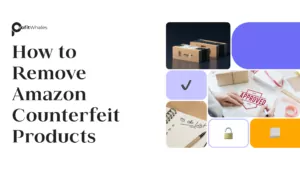Introduction
The prevalence of Amazon counterfeit products poses a significant threat to legitimate sellers and brands. Counterfeit items damage the reputation of authentic brands and erode consumer trust in the platform. Understanding how to identify and remove Amazon counterfeits is crucial for maintaining your brand’s integrity and ensuring that customers receive genuine products. This comprehensive guide will walk you through the steps necessary to report and remove counterfeit products from Amazon, utilizing various tools and strategies to protect your intellectual property.
Step 1: Set Up Your Amazon Account
Before removing counterfeit Amazon products, you need to have an Amazon account. Here’s how to set it up:
Why You Need an Amazon Account
An Amazon account is essential as it allows you to access all the necessary tools and resources to protect your brand from counterfeit items on Amazon. With an account, you can utilize the Amazon Brand Registry, report infringements, or manage your product listings effectively.
Step-by-Step Guide to Creating Your Amazon Account
- Visit Amazon’s Website: Go to the Amazon homepage and click the “Create your Amazon account” button.
- Provide Your Details: Fill in the required fields, including your name, email address, and a secure password.
- Verify Your Email: Amazon will send you a verification code via email. Enter this code to verify your account.
- Add Payment Information: To complete your account setup, add your payment information. This is necessary for any future transactions.
- Set Up Two-Factor Authentication: Enhance your account security by enabling two-factor authentication.
A fully set up Amazon account is the first step in protecting your brand from counterfeit items on Amazon.
Step 2: Register with the Amazon Brand Registry
The Amazon Brand Registry is a powerful tool for protecting brand owners’ intellectual property and product listings. Registering your brand with the Amazon Brand Registry provides access to additional features that make it easier to identify and report Amazon counterfeit products.
Why Joining Amazon Brand Registry is Crucial
Joining the Amazon Brand Registry provides several key benefits:
- Enhanced Brand Protection: Gain access to powerful tools that help you identify and report Amazon counterfeit products.
- Greater Control Over Listings: Ensure your product listings are accurate and protected from unauthorized changes.
- Access to Advanced Search Tools: Use proprietary text and image search tools to find infringing products more efficiently.
- Brand Support: Receive dedicated support from Amazon’s brand protection team.
How to Sign Up for the Amazon Brand Registry
- Enroll Your Brand: Go to the Amazon Brand Registry website and click on “Enroll Now”.
- Provide Brand Information: Enter your brand name, registration number, and the country where your trademark is registered.
- Verify Your Identity: Amazon may require documentation to verify that you are the legitimate owner of the brand. This might include submitting your trademark certificate and other relevant documents.
- Complete the Enrollment: Once your brand is verified, you will gain access to the tools provided by the Amazon Brand Registry.
By joining the Amazon Brand Registry, you will have enhanced capabilities to monitor and report counterfeit Amazon products, protecting your brand from potential infringement.
Step 3: Submit Your Intellectual Property (IP) Documents
Submitting your intellectual property documents is essential in safeguarding your brand against Amazon counterfeits. Proper documentation ensures that Amazon can validate your claims and take appropriate action against counterfeit sellers.
Types of IP Documents Required
To effectively protect your brand, you need to provide Amazon with the following types of IP documents:
- Trademark Registration Certificate: Proof that your brand name and logo are legally protected.
- Patent Documents: Provide copies of your patent certificates if you have patented products.
- Copyright Certificates: If applicable, include certificates for copyrighted material.
- Design Patents: Include documentation for any unique product designs you have registered.
How to Prepare and Submit Your IP Documents
Gather Necessary Documents: Prepare all relevant IP documents, including your trademark registration certificate, patent documents (if applicable), and other proof of ownership.
- Upload Documents to Amazon: You can upload these documents through the Amazon Brand Registry portal. Ensure that the files are clear and legible.
- Provide Detailed Information: Include detailed descriptions of your products, design elements, and any unique identifiers that distinguish your genuine products from knockoffs on Amazon.
- Regularly Update Your Information: Keep your IP documents and brand information up to date to ensure continuous protection.
Submitting these documents helps Amazon verify your rights and act promptly against counterfeit listings.
Step 4: Report the Infringement
Reporting counterfeit items on Amazon is critical in removing them from the platform. Here’s how to effectively report infringement:
Identifying Counterfeit Products
To effectively identify Amazon counterfeit products, follow these steps:
- Regularly Monitor Listings: Use the tools available in the Amazon Brand Registry to keep an eye on new listings of your products.
- Check Product Details: Look for product descriptions, images, and price discrepancies that may indicate a counterfeit.
- Customer Reviews: Pay attention to customer reviews and feedback, which can often reveal issues with counterfeit products.
Detailed Instructions on Reporting Infringements on Amazon
- Gather Evidence: Take screenshots of the counterfeit listings, noting the seller’s name, product details, and any discrepancies between the fake and authentic products.
- Report to Amazon: Through the Amazon Brand Registry portal, navigate to the “Report a Violation” section. Provide all necessary details and upload your evidence.
- Submit the Report: After completing the form, submit it for review. Amazon will investigate the claim and take appropriate action.
- Follow Up: Keep track of your report’s status and respond to any requests for additional information from Amazon.
Effective Amazon counterfeit reporting requires thorough documentation and clear evidence to ensure that Amazon can take swift action against the infringing products.
Step 5: Submit the Report and Wait for Processing
After submitting your report, there are a few things you should know about the processing phase:
What to Expect After Submitting the Report
- Acknowledgment of Receipt: Amazon will send a confirmation email acknowledging receipt of your report.
- Investigation Process: Amazon will review your submission, verify the provided evidence, and assess the legitimacy of your claim.
- Timeline: The review process can take several days to a few weeks, depending on the complexity of the case and the volume of reports.
- Follow-Up: Check your email for updates from Amazon. They may request additional information or clarification during the investigation.
Timeline and Follow-Up Procedures
- Initial Review: Amazon typically begins with an initial review to assess the validity of your claim.
- Detailed Investigation: If your claim is deemed valid, Amazon will conduct a more detailed investigation, which may involve contacting the seller and verifying the product details.
- Resolution: After the investigation is completed, Amazon will take appropriate action, including removing the counterfeit listing and penalizing the seller.
- Notification: You will receive a notification regarding the outcome of your report. You will be informed of the action taken if the counterfeit is removed.
Patience and thoroughness are essential during this phase. Providing all necessary information increases the chances of a successful outcome.
Automate Your IP Protection
Manual monitoring and reporting can be time-consuming. Automating your IP protection can streamline this process.
Tools and Services to Automate IP Protection
- Amazon’s Automated Brand Protection Tools: Utilize Amazon’s built-in tools to detect and remove counterfeits automatically.
- Third-Party Services: Consider using third-party services like Corsearch, which specializes in monitoring and reporting counterfeit Amazon products.
- Custom Solutions: Work with developers to create custom solutions tailored to your specific needs and product lines.
Benefits of Automating Your IP Protection Efforts
- Efficiency: Automated tools can scan millions of listings, identifying potential infringements faster than manual methods.
- Consistency: Automation ensures continuous monitoring without lapses, providing consistent protection.
- Scalability: As your brand grows, automated tools can scale with you, handling increased volumes of potential infringements.
Automating your IP protection helps maintain the integrity of your brand while saving time and resources.
Discover the Latest Trends and Challenges in IP Protection
Staying informed about the latest trends and challenges in IP protection is crucial for effective brand management.
Current Trends in IP Protection
In recent years, several key trends have significantly transformed the landscape of IP protection. One of the most notable developments is the rise of advanced detection technologies. New technologies that utilize artificial intelligence (AI) and machine learning are emerging, offering the capability to detect counterfeit products with unprecedented accuracy. These AI-powered systems can quickly analyze vast amounts of data, identifying patterns and anomalies that might indicate counterfeit activities. This level of precision speeds up the detection process and minimizes the likelihood of false positives, ensuring that genuine products are not mistakenly flagged as counterfeits.
Global enforcement is another crucial trend shaping IP protection. With counterfeiters operating across borders, global collaboration is increasingly emphasized to tackle cross-border IP infringements. International cooperation among governments, law enforcement agencies, and private sector organizations is becoming more prevalent. These entities can more effectively dismantle international counterfeit networks by sharing information and coordinating actions. This collaborative approach provides a unified front against IP theft and strengthens the overall enforcement framework.
Enhanced consumer awareness also plays a pivotal role in the fight against counterfeit products. Consumers are becoming more knowledgeable about the dangers and prevalence of counterfeit goods, partly due to educational campaigns and extensive media coverage. This growing awareness leads to more vigilant consumers who are better equipped to identify and avoid counterfeit products. As a result, consumers’ reporting of counterfeit goods increases, which puts additional pressure on platforms like Amazon to take decisive action against sellers of fake products. This heightened consumer scrutiny helps maintain trust in online marketplaces and encourages proactive measures to combat counterfeiting.
In addition to these primary trends, blockchain technology is gaining traction as a powerful tool for IP protection. Blockchain provides a secure and transparent method for tracking the provenance of products, ensuring that each item can be authenticated at every stage of the supply chain. This technology helps prevent counterfeits from infiltrating the market and offers consumers a reliable means to verify the authenticity of their purchases.
Common Challenges and How to Address Them
Evolving Tactics by Counterfeiters
Counterfeiters are constantly evolving their tactics to evade detection and enforcement. They employ sophisticated methods such as changing product details, using deceptive listings, and exploiting gaps in the monitoring systems of online platforms like Amazon. Counterfeiters may also frequently alter their seller accounts, making tracking and shutting them down permanently challenging. To stay ahead of these evolving tactics, brands need to adopt adaptive strategies that include continuous monitoring and regular updates to their detection methods. Advanced technologies like AI and machine learning can be instrumental in identifying new patterns and trends in counterfeit activities, enabling brands to respond swiftly and effectively. Additionally, investing in comprehensive training for staff to recognize and report counterfeit strategies is crucial for maintaining a robust defense against these ever-changing threats.
Legal and Regulatory Hurdles
The complexity of legal and regulatory environments across different countries poses a significant challenge for brands trying to enforce their intellectual property rights. Each country has its own set of IP laws and enforcement mechanisms, which can vary widely in effectiveness and stringency. Navigating these diverse legal landscapes requires a deep understanding of international IP law and often requires working with experts specializing in global IP protection. Collaborating with international IP law firms can help brands develop strategies tailored to each jurisdiction, ensuring their IP rights are upheld consistently across borders. Additionally, brands should stay informed about IP laws and regulations changes to adapt their enforcement strategies accordingly. Participating in international coalitions and advocacy groups can strengthen global efforts to harmonize IP protection laws and improve enforcement measures.
Resource Limitations
Smaller brands often face significant resource limitations that can hinder their ability to implement effective IP protection measures. Compared to larger companies, smaller brands may need more financial and human resources to monitor for counterfeits and take appropriate action against infringers continuously. However, leveraging automated tools and third-party services can help mitigate this issue. Automated IP protection tools can continuously monitor online marketplaces, flagging potential infringements without extensive manual intervention. These tools can quickly analyze vast amounts of data, identifying counterfeit products more efficiently than traditional methods. Additionally, outsourcing IP protection to specialized third-party services can provide smaller brands access to expertise and otherwise unavailable resources. These services can handle the complexities of monitoring, reporting, and legal enforcement, allowing smaller brands to focus on their core business activities while protecting their intellectual property.
Understanding these trends and challenges helps brands develop more robust IP protection strategies.
Summary
Removing Amazon counterfeit products requires a multi-faceted approach, including setting up your Amazon account, registering with the Amazon Brand Registry, submitting IP documents, and effectively reporting infringements. Automating your IP protection efforts and staying informed about the latest trends and challenges strengthens your brand’s defenses. By taking these steps, you can protect your brand’s integrity and ensure that customers receive genuine products.
For tailored tips and advanced strategies to safeguard your brand on Amazon, visit Profit Whales. If you’re looking for personalized assistance, don’t hesitate to contact us. Our dedicated team is here to help you protect your business and excel on Amazon!
FAQs
How do I report counterfeit products on Amazon without a test buy?
You can report counterfeit products on Amazon by using the tools provided by the Amazon Brand Registry. Gather evidence such as screenshots and product details, then submit a report through the “Report a Violation” section.
What is Amazon’s program to track counterfeiters?
Amazon’s Project Zero and Transparency programs are designed to identify and track counterfeiters, helping to remove fake products from the platform.
How can I get a refund for counterfeit items on Amazon?
If you receive a counterfeit item, you can file a claim through Amazon’s A-to-Z Guarantee. Provide evidence that the product is counterfeit, and Amazon will process your refund.
What documents do I need to submit for Amazon counterfeit reporting?
You will need to submit your trademark registration certificate, detailed descriptions of your products, and any other relevant IP documents to support your claim.
How long does it take for Amazon to process a counterfeit report?
The processing time can vary, but typically it takes several days to a few weeks for Amazon to investigate and take action on a counterfeit report.
By following these steps and utilizing available tools and resources, you can effectively combat counterfeit Amazon products and protect your brand’s reputation.








